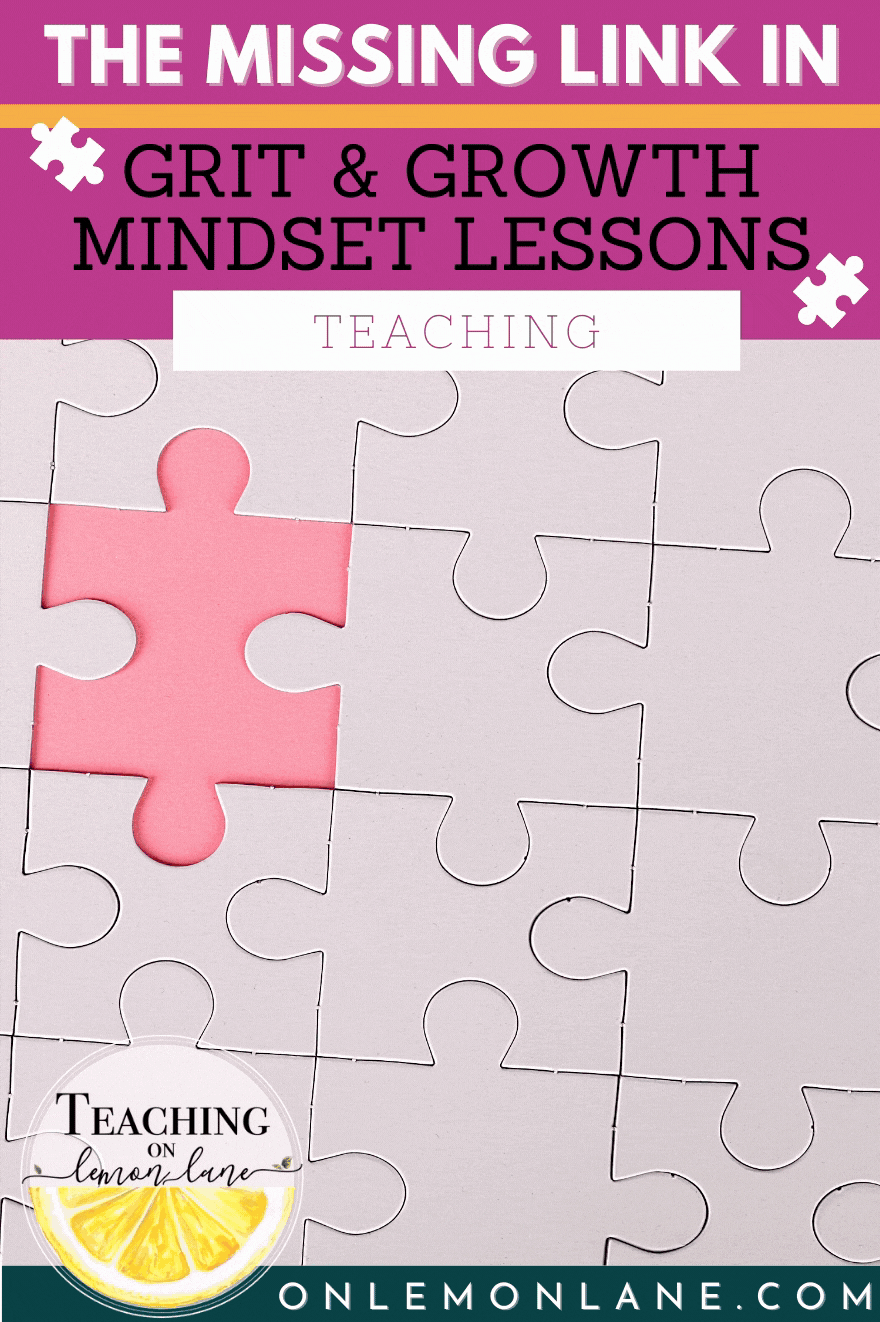
Having grit and a growth mindset are hot topics in the classroom at the moment and for very good reason.
The problem is that most products, blog posts, and resources only discuss:
- What it is
- What it looks like
- The importance of it
This line of products allows you to explicitly teach it…by facilitating failure.
Click Here to Learn More About the Nitty-Gritty BUNDLE

Facilitate Failure in the Classroom
The activities included in this product line are designed to make your students struggle and fail…tossing them into the depths of the learning pit.
Sound a little harsh?
Maybe.
But I can’t think of a better place than the safety of the classroom, in a controlled environment, under the watchful eye of a loving teacher for students to exercise grit and growth mindset.
By facilitating failure, you and your students are able to pinpoint how students uniquely respond to those tough emotions and negative thoughts. This allows students to better recognize them, make sense of them, and in return…
How to capitalize on them.

“I have learned that success is to be measured not so much by the position that one has reached in life as by the obstacles overcome while trying to succeed.”
– Booker T. Washington

What is grit? What is a growth mindset? How are they related?
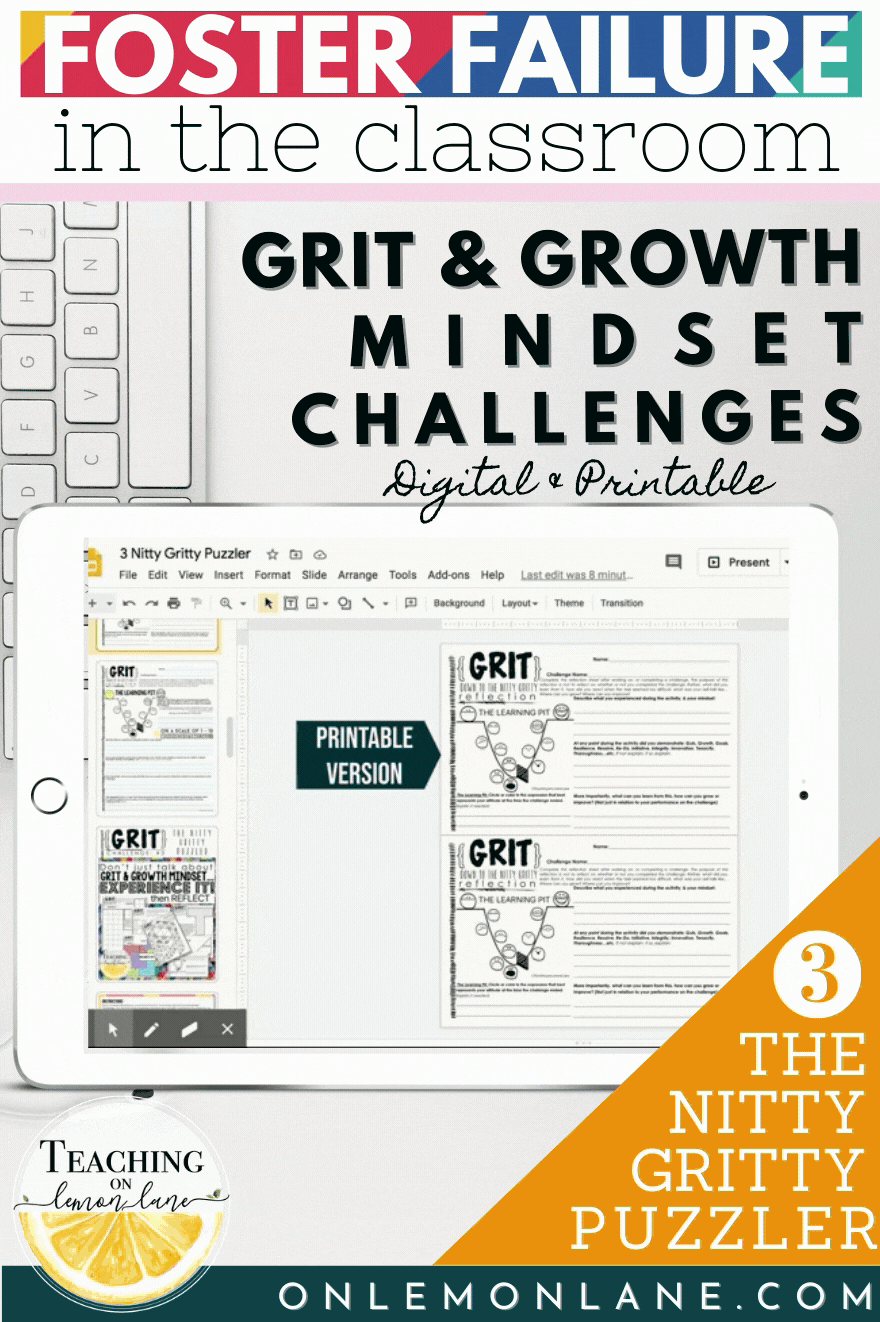 Technically speaking, you could define grit as a personality trait that individuals demonstrate when they work towards a goal with optimism despite facing setbacks, obstacles, or distractions. Studies show that individuals with grit are better able to self-regulate, have a higher degree of social/emotional intelligence, and are less dependent on outside reinforcements because they are internally self-sufficient.
Technically speaking, you could define grit as a personality trait that individuals demonstrate when they work towards a goal with optimism despite facing setbacks, obstacles, or distractions. Studies show that individuals with grit are better able to self-regulate, have a higher degree of social/emotional intelligence, and are less dependent on outside reinforcements because they are internally self-sufficient.
Grit is essentially a trait that can be found in individuals that possess a growth mindset. It could even be said that grit is what students are developing and exercising when they are practicing having a growth mindset.
Growth mindset, on the other hand, can be defined as the belief that talent, intelligence, skills, or proficiency can grow when individuals are willing to practice, put forth effort, and exercise grit.
Why is grit and having a growth mindset important?
It is important to note that neither grit nor growth mindset is static.
Both can be learned.
Both are skills that can be practiced, reformed, and improved. They are not traits or characteristics that some are born with and some are not. Thus we can see the importance of practicing them and facilitating failure in the classroom.
- “…Demonstrate an increased level of self-control, mental well-being, life satisfaction, feelings of worth, resilience and growth mindset.
- Gritty students were more likely to illustrate a decreased level of perceived stress (Studies 1 and 2).
- High achieving, successful students were consistently more likely to have overcome personal challenges and obstacles and persevere despite facing obstacles and barriers (Studies 2 and 3).
- These students were able to strongly identify their long-term goals and strived toward the achievement of these goals with the intention to prove a point (Study 3).
- Excellent time-management and prioritizing skills were evident in successful students, along with their ability to express self-awareness (Study 3).
- These high-achieving students held a positive attitude toward learning and life in general and stressed the importance of feedback and constructive criticism in their personal development and growth (Study 3).
- Finally, these students did not believe success was materialistic. They stressed the importance of happiness, independence, comfort and a stress-free life while recognizing the responsibility they held over their own success (Study 3).”
How to Teach Grit and Growth Mindset in the Classroom
Creating experiences like those mentioned above helps lead to an increase in resilience in the classroom, thus allowing students to practice having grit and a growth mindset…instead of just talking about what it is.
- First, people mix up open-mindedness and positivity with having a growth mindset, believing that they have always had a growth mindset and therefore always will.
- Second, some people believe that praising and rewarding effort is all that matters.
- Finally, sometimes people think that if they talk about a growth mindset, or put up posters about it, that is all that is needed. Without doing any work to create a growth mindset culture or environment, those posters are just papers on a wall.
Click Here to Learn More About the Nitty-Gritty BUNDLE

“Sometimes people think that if they talk about a growth mindset, or put up posters about it, that is all that is needed. Without doing any work to create a growth mindset culture or environment, those posters are just paper on a wall.”

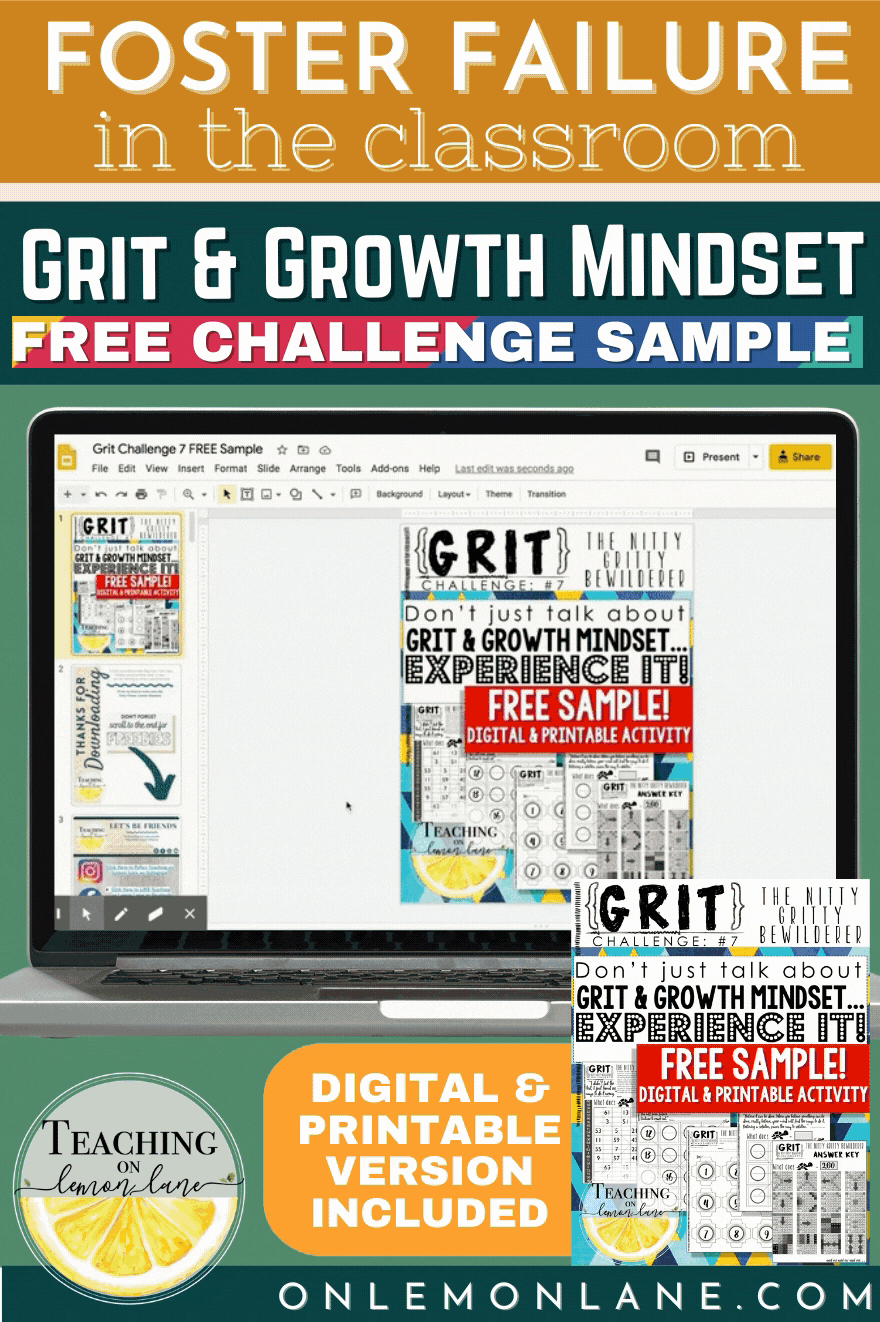 If we are going to “really” teach students what it is to have grit and a growth mindset, then we are going to have to “really” give students opportunities to experience AND practice it.
If we are going to “really” teach students what it is to have grit and a growth mindset, then we are going to have to “really” give students opportunities to experience AND practice it.
As noted, it is not enough to just talk about what it is, what it looks like, and hang up motivational posters in the classroom.
Whether you are an upper elementary, middle school, or high school teacher, these challenges can be implemented into your classroom. I’ve even received messages from school administrations using these challenges in staff trainings.
These challenges are applicable to such a wide range of grade and age levels because they are based on:
- Thinking outside the box
- Persevering to solve
- Learning from mistakes
There is never a wrong time to facilitate failure in the classroom. I’ve designed these challenges to last the entire year.
Wisdom
My team and I would introduce this type of activity during the first week of school. This thoughtful idea to introduce failure came from one of my favorite colleagues. We used it for the first day of math class. Based on what we observed, experienced, and discussed, this type of activity will forever hold a spot in the first week of school lineup.
Probably the most surprising outcome of this activity was how my gifted and talented students responded.
When you think of it, the students with the least amount of exposure to exercising grit or a growth mindset are the students that school comes the easiest to.
The grittiest students are those that are used to struggling and working hard every. single. day. There is so much value in these lessons and the discussions and experiences they bring.
It is simply not enough to define what grit and a growth mindset is: it must be practiced in a controlled environment where you can mentor them through their thought process. Instead of hoping they apply what you discussed in a lesson when their trial comes along, you can be confident in knowing you have given them adequate practice and necessary skills.

Application
A tough activity designed to encourage failure is the perfect discussion starter as to why it is so important we facilitate a growth mindset and know what grit is.
Once introduced, I continue to introduce approximately one new activity a week until the end of the year. I like to give students about a week per activity.
This gives them time to wrestle strategies or questions and ponder on the challenge at hand.
***Remember a key component of grit is endurance.
Grit is something displayed over time.***
As tempting as it is to give them the answers they so desperately want, the wrestle is the most important part. With many of these challenges, the solution is SIMPLE. However, it requires the students to think outside the box. This thought process will not come if time is not afforded. Plus, the joy and satisfaction are that much greater once a struggle and multiple failures have been encountered.
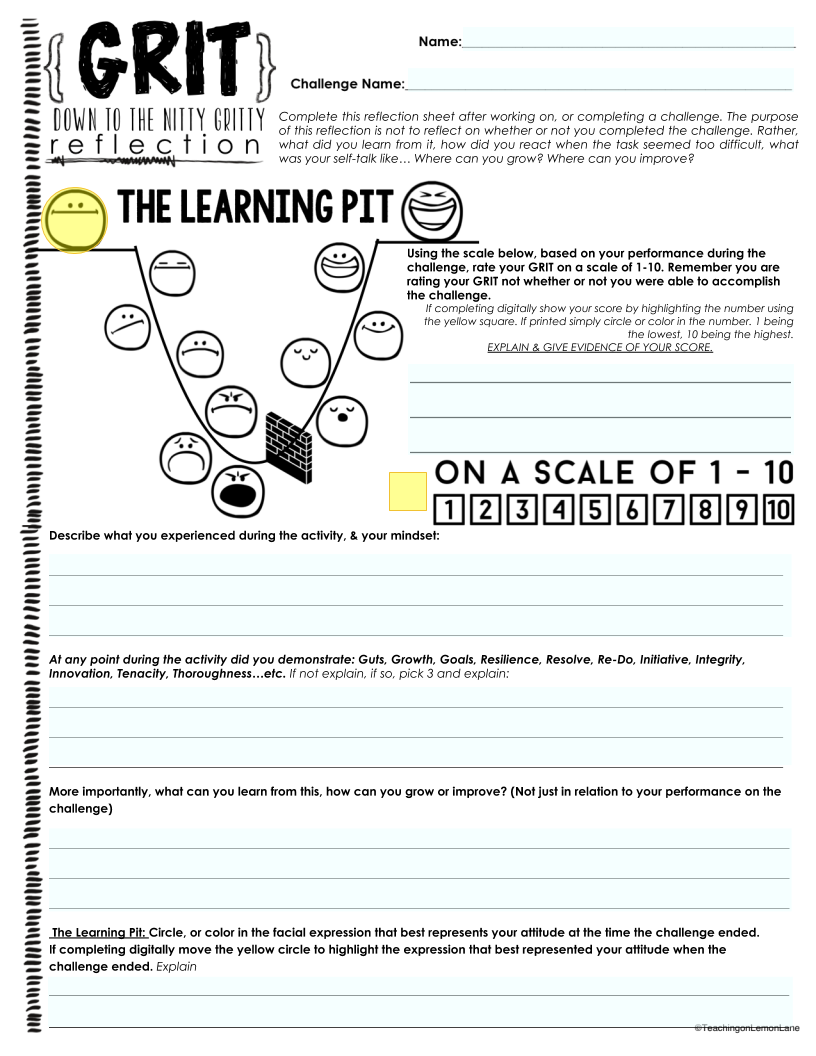 Reflection
Reflection
My favorite part of this product line is the reflection sheet.
Students identify an emotion in the learning pit that best illustrates where they were before the activity ended. The reflection page is only included in the paid products, not the free samples or activities
Free Samples or Activities:
-
The Big Scribb (🍋Free)
-
The Thingamajig Challenge 6 (🍋Free to On Lemon Lane Members)
-
The Bewilderer (🍋 FREE sample sent straight to your email. Enter your email above or below.)
The following activities listed above do not include the reflection sheet.
If you love this activity and you’re on board with facilitating failure throughout the school year, make sure to check out these activities. Remember the reflection sheets are included with the paid challenges.
Simply Stated
Of all the things we teach our students, it’s hard to think of a concept or objective in the curriculum as important as instilling grit or how to have a growth mindset. Giving students the tools they need to face adversity or challenges with optimism, control, and resilience is a skill that will carry them to a brighter future.
That’s the goal of educators everywhere: provide students the tools to create a brighter future.
The Nitty-Gritty MEGA Bundle
If this resonates with you, check out the Nitty-Gritty MEGA BUNDLE. These activities were created to be used together throughout the year. When you purchase the bundle instead of individual challenges, you save BIG. So big TPT actually warns me about my bundle discounts! 😅 This product includes access to over 60 pages and 35 DIGITAL and printable activities. You can also purchase the challenges individually. See descriptions for more information.
The Nitty-Gritty Bundle includes the reflection page as well as challenges 1-5 and 7. Challenge 6 is a free exclusive to On Lemon Lane Members.
Not a member? Not a problem. Sign up is FAST, FREE, and Easy-Peasy, Lemon-Squeezy! Click here to become a member! Already a member? Click here to sign in.
Click Here to SHOP the Nitty-Gritty BUNDLE.
***This product line has been updated. Many of the challenges now have a digital counterpart and work perfectly as a Google Slide assignment! See product descriptions for more information.***
Want to learn more about each challenge? Click here for a more in-depth look at each activity!
Try it for FREE
The following downloads are FREE or include a FREE Sample. Put your email in the form below to have a FREE sample of The Nitty-Gritty Bewilderer Challenge #7 delivered straight to your inbox!
- The Big Scribb Whole Class Activity: FREE
- The Nitty-Gritty Thingamajig Challenge 6: FREE
- The Nitty-Gritty Bewilderer Challenge 7: FREE Sample Challenge sent STRAIGHT to your inbox!
PHEW.
As far as I’m concerned, there’s no better place to foster failure than in the classroom with a teacher like you as their guide through the depths of the learning pit. Skills like these will carry students through more than just academics.
Can’t wait to hear what you think! Better yet, what did your students think? Comment below or let’s connect on Instagram or Facebook! Share pictures, pretty please!
Like this? Make sure to check out these 🍋Included Freebies!🍋
Click on the image to learn more.

To stay up-to-date on new blog posts, freebies, exclusive promo codes, and sales, join the Teaching on Lemon Lane Community! Pick any or all of the following to stay in the loop of all things Teaching on Lemon Lane.
- Follow @TeachingonlemonLane on Instagram
- Like Teaching on Lemon Lane on Facebook
- Join our exclusive Teaching on Lemon Lane Facebook Group
- Sign up for our monthly newsletter. No spam–only make your life Easy-peasy, Lemon-squeezy goodness. I promise.
If you enjoyed this, PLEASE SHARE! Sharing on Pinterest, Facebook, or tagging on Instagram is a simple yet wonderful way to support the efforts of Teaching on Lemon Lane!
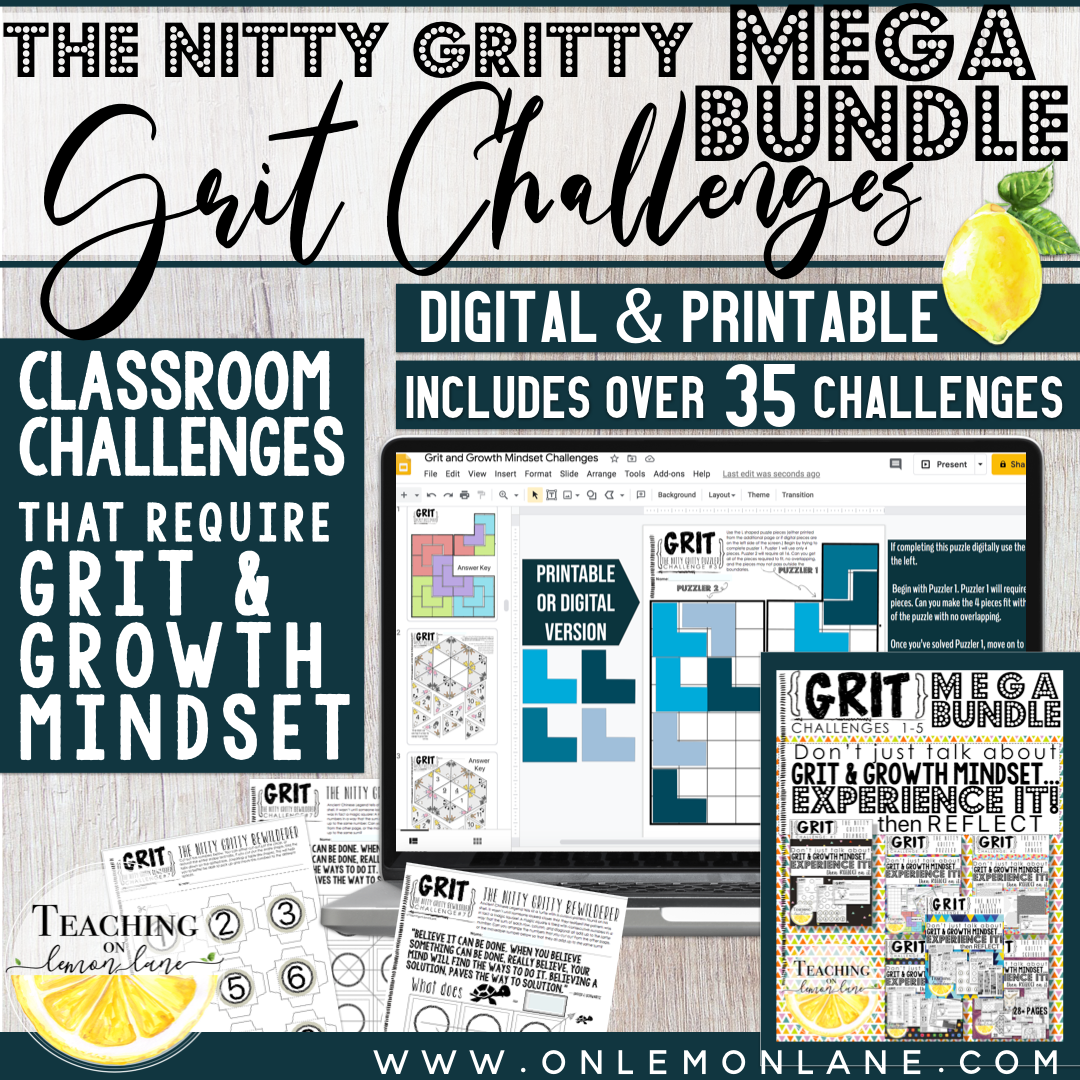
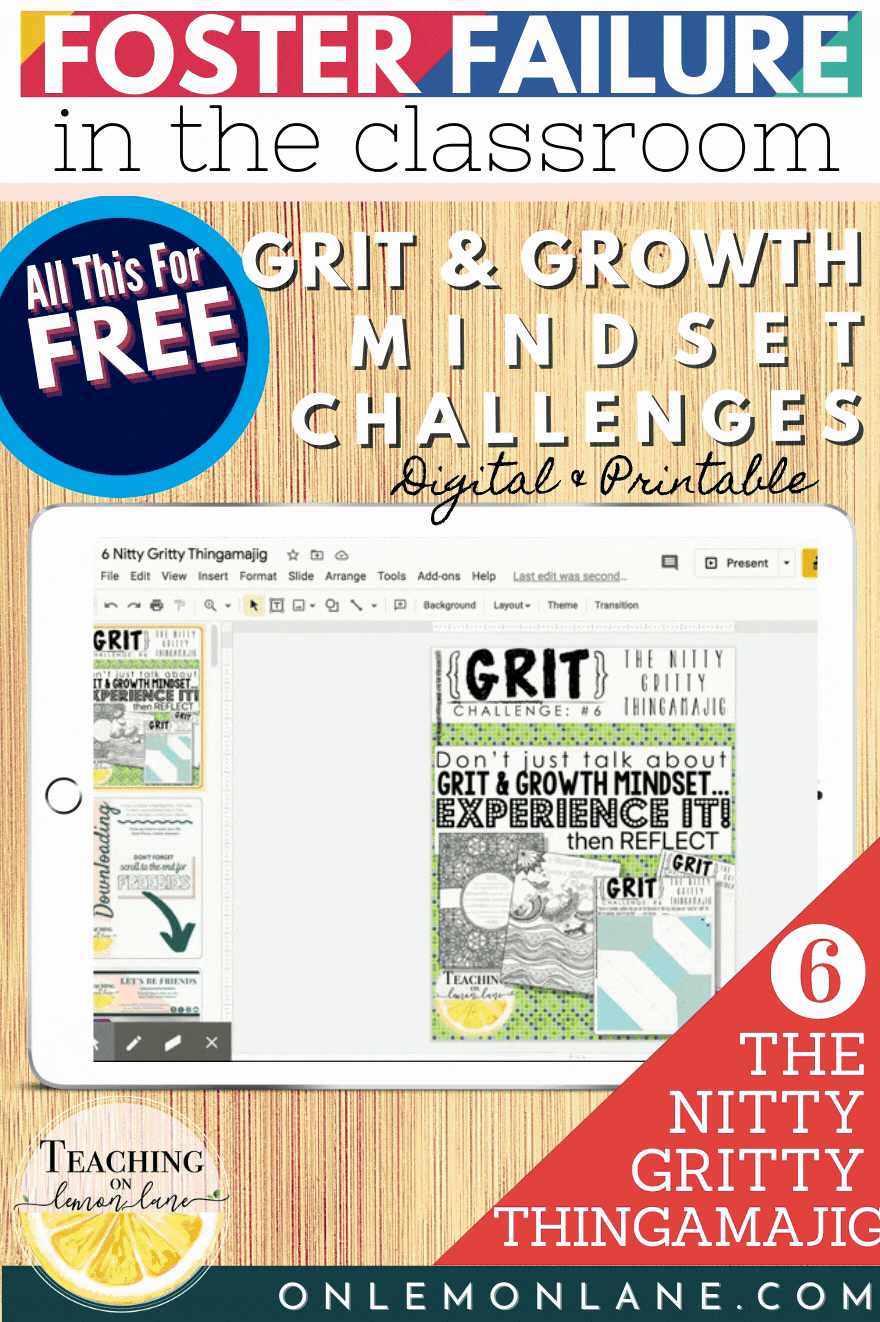

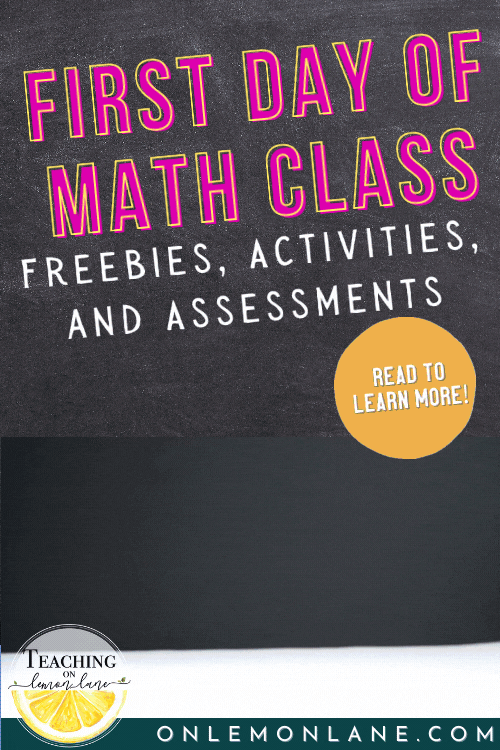
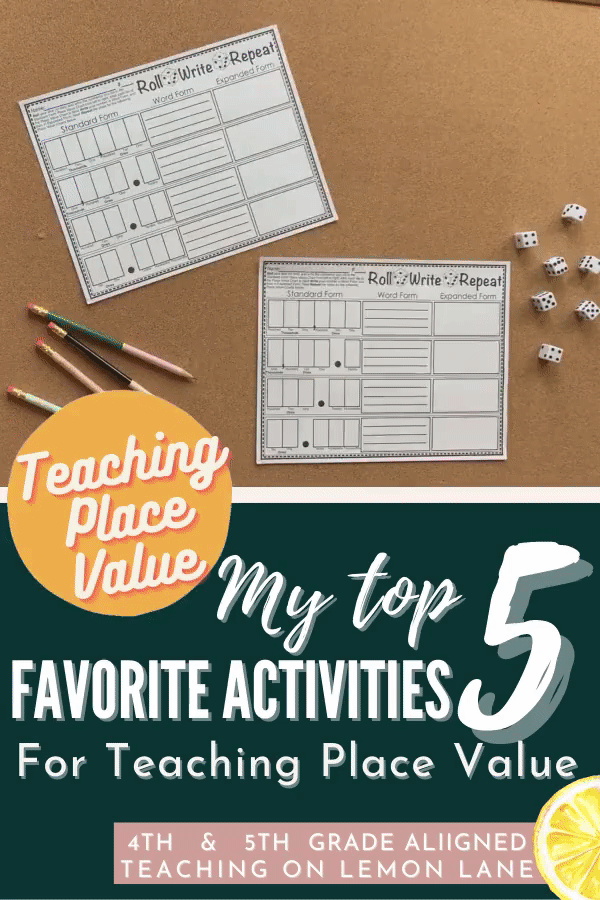
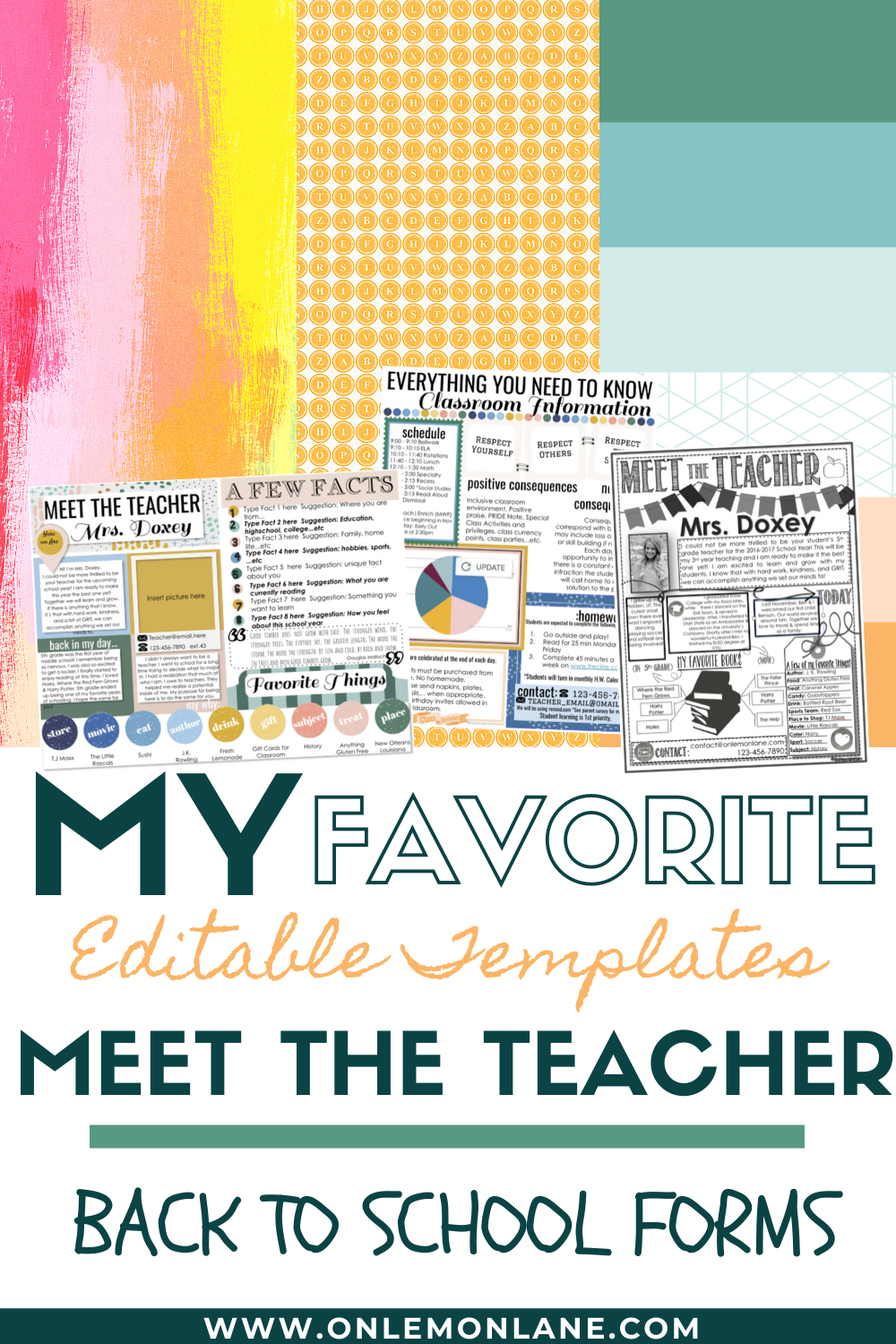
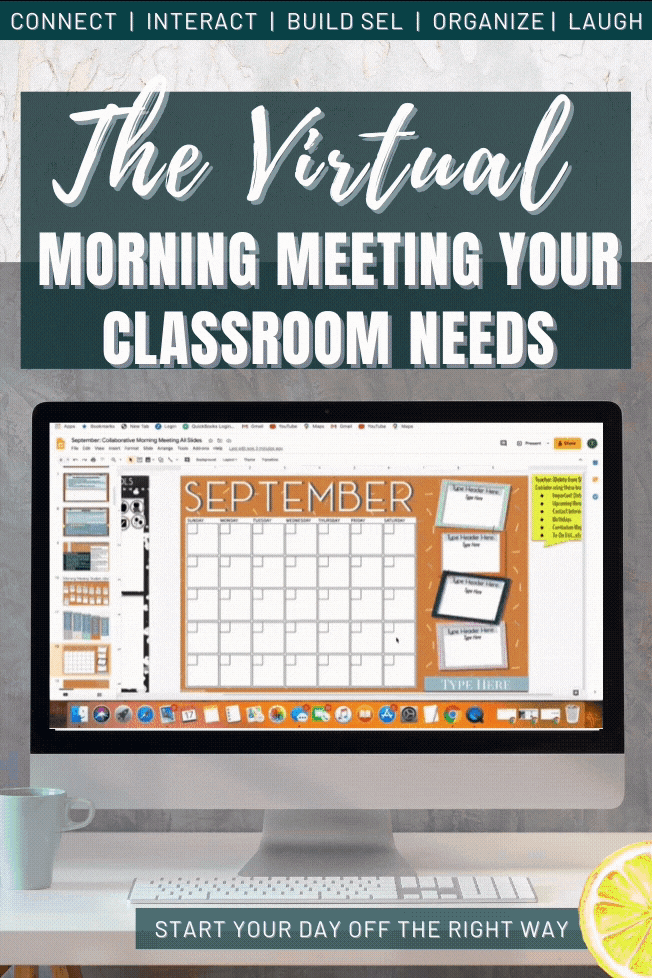

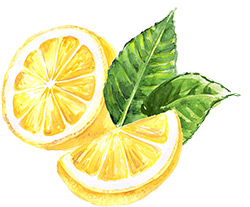

bmcbrien says
I love that you included the learning pit reflection page with these activities. One of the questions says “At any point during the activity did you demonstrate: Guts, Growth, Goals, Resilience, Resolve, Re-Do, Initiative, Integrity, Innovation, Tenacity, Thoroughness…etc. ” Do you have a PowerPoint or other resource that defines these terms for students?